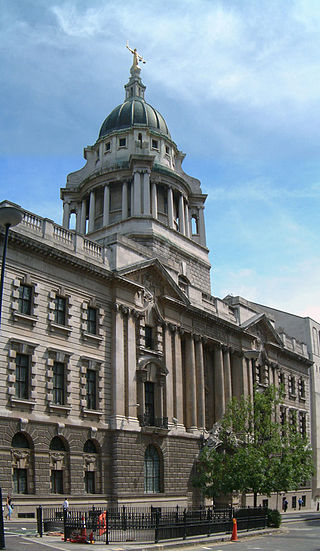Related Research Articles

In law, a trust refers to a relationship in which the owner of property gives it to a designated entity, usually described as a trustee. The trustee has a duty to safeguard and use the assets of the trust solely for the benefit of another person or group of persons until distribution, pursuant to the provisions of the trust. In the English common law tradition, the party who entrusts the property is known as the "settlor", the party to whom the property is entrusted is known as the "trustee", the party for whose benefit the property is entrusted is known as the "beneficiary", and the entrusted property itself is known as the "corpus" or "trust property". A testamentary trust is an irrevocable trust that is established and funded pursuant to the terms of a deceased person's will. An inter vivos trust is a trust created during the settlor's lifetime.

Trustee is a legal term which, in its broadest sense, is a synonym for anyone in a position of trust and so can refer to any individual who holds property, authority, or a position of trust or responsibility for the benefit of another. A trustee can also be a person who is allowed to do certain tasks but not able to gain income. Although in the strictest sense of the term a trustee is the holder of property on behalf of a beneficiary, the more expansive sense encompasses persons who serve, for example, on the board of trustees of an institution that operates for a charity, for the benefit of the general public, or a person in the local government.

A fiduciary is a person who holds a legal or ethical relationship of trust with one or more other parties. Typically, a fiduciary prudently takes care of money or other assets for another person. One party, for example, a corporate trust company or the trust department of a bank, acts in a fiduciary capacity to another party, who, for example, has entrusted funds to the fiduciary for safekeeping or investment. Likewise, financial advisers, financial planners, and asset managers, including managers of pension plans, endowments, and other tax-exempt assets, are considered fiduciaries under applicable statutes and laws. In a fiduciary relationship, one person, in a position of vulnerability, justifiably vests confidence, good faith, reliance, and trust in another whose aid, advice, or protection is sought in some matter. In such a relation, good conscience requires the fiduciary to act at all times for the sole benefit and interest of the one who trusts.
A fiduciary is someone who has undertaken to act for and on behalf of another in a particular matter in circumstances which give rise to a relationship of trust and confidence.

In common law jurisdictions, probate is the judicial process whereby a will is "proved" in a court of law and accepted as a valid public document that is the true last testament of the deceased, or whereby the estate is settled according to the laws of intestacy in the state of residence of the deceased at time of death in the absence of a legal will.

In trust law, an express trust is a trust created "in express terms, and usually in writing, as distinguished from one inferred by the law from the conduct or dealings of the parties." Property is transferred by a person to a transferee, who holds the property for the benefit of one or more persons, called beneficiaries. The trustee may distribute the property, or the income from that property, to the beneficiaries. Express trusts are frequently used in common law jurisdictions as methods of wealth preservation or enhancement.

Bartlett v Barclays Bank Trust Co Ltd [1980] 1 Ch 515 in an English trusts law case. In it Brightman J gave a comprehensive discussion of the duties of trustees in connection with companies whose shares are part of the trust property. Although it is common to hear lawyers refer to "the rule in Bartlett v Barclays Bank", the case only restated law that had been accepted since Speight v Gaunt.

Re Atkinson, Barbers' Company v Grose-Smith [1904] 2 Ch 160 is an English trusts law case, which lays down a rule of equity relating to the disposition by the trustees of an authorised mortgage security where the security forms part of a trust fund, and the beneficiaries of the trust fund include a tenant for life and a remainderman. Where the security is sold and the proceeds are insufficient to satisfy the principal and interest in full, it is necessary to determine the way in which the loss shall be shared as between the tenant for life and the remainderman. The sum realised by the sale must be apportioned between the life tenant and the remainderman in the proportion that the amount due for the arrears of interest bears to the amount due in respect of principal.

Saunders v Vautier[1841] EWHC J82, (1841) 4 Beav 115 is a leading English trusts law case. It laid down the rule of equity which provides that, if all of the beneficiaries in the trust are of adult age and under no disability, the beneficiaries may require the trustee to transfer the legal estate to them and thereby terminate the trust. The rule has been repeatedly affirmed in common law jurisdictions, and is commonly referred to as "the rule in Saunders v Vautier" for shorthand.

Allhusen v Whitell (1867) LR 4 Eq 295 is an English trusts law case which lays down a rule of equity which requires the trustee of a trust to strike a fair balance between the beneficiaries who are tenants for life and those who are remaindermen in respect of payment of the debts of an estate. The life tenant under a will is entitled to income earned after the testator's death, but it often takes some time to ascertain and settle all of those debts. In the meantime the assets of the estate are earning income for tenant for life, whereas the life tenant should only receive income from the estate net of the debts; the rule in Allhusen v White requires the life tenant to make a contribution.

Howe v Earl of Dartmouth (1802) 7 Ves 137 is an English trusts law case. It laid down the rule of equity in relation to the duties of a trustee in relation to a trust fund where there are successive interests in relation to the trust fund, and seeks to strike a fair balance between the rights of the life tenant and the remainderman. It is one of a number of highly technical common law rules which causes considerable angst where wills and trusts have not been professionally prepared.

An interest in possession trust is a trust in which at least one beneficiary has the right to receive the income generated by the trust or the right to enjoy the trust assets for the present time in another way. The beneficiary with the right to enjoy the trust property for the time being is said to have an interest in possession and is colloquially described as an income beneficiary, or the life tenant.

United States trust law is the body of law that regulates the legal instrument for holding wealth known as a trust.
Australian trust law is the law of trusts as it is applied in Australia. It is derived from, and largely continues to follow English trust law, as modified by state and federal legislation. A number of unique features of Australian trust law arise from interactions with the Australian systems of company law, family law and taxation.

English trust law concerns the protection of assets, usually when they are held by one party for another's benefit. Trusts were a creation of the English law of property and obligations, and share a subsequent history with countries across the Commonwealth and the United States. Trusts developed when claimants in property disputes were dissatisfied with the common law courts and petitioned the King for a just and equitable result. On the King's behalf, the Lord Chancellor developed a parallel justice system in the Court of Chancery, commonly referred as equity. Historically, trusts have mostly been used where people have left money in a will, or created family settlements, charities, or some types of business venture. After the Judicature Act 1873, England's courts of equity and common law were merged, and equitable principles took precedence. Today, trusts play an important role in financial investment, especially in unit trusts and in pension trusts. Although people are generally free to set the terms of trusts in any way they like, there is a growing body of legislation to protect beneficiaries or regulate the trust relationship, including the Trustee Act 1925, Trustee Investments Act 1961, Recognition of Trusts Act 1987, Financial Services and Markets Act 2000, Trustee Act 2000, Pensions Act 1995, Pensions Act 2004 and Charities Act 2011.

Armitage v Nurse [1997] EWCA Civ 1279 is the leading decision in English trusts law concerning the validity of exemption clauses. The Court of Appeal held that in English law trustee exemption clauses can validly exempt trustees from liability for all breaches of trust except fraud. Millett LJ gave the leading judgment.

Learoyd v Whiteley[1887] UKHL 1 is an English trusts law case, concerning the duty of care owed by a trustee when exercising the power of investment.

The Trustee Act 2000 is an act of the Parliament of the United Kingdom that regulates the duties of trustees in English trust law. Reform in these areas had been advised as early as 1982, and finally came about through the Trustee Bill 2000, based on the Law Commission's 1999 report "Trustees' Powers and Duties", which was introduced to the House of Lords in January 2000. The bill received the Royal Assent on 23 November 2000 and came into force on 1 February 2001 through the Trustee Act 2000 (Commencement) Order 2001, a Statutory Instrument, with the Act having effect over England and Wales.

Speight v Gaunt [1883] UKHL 1 is an English trusts law case, concerning the extent of the duty of care owed by a fiduciary.
Cowan v Scargill [1985] Ch 270 is an English trusts law case, concerning the scope of discretion of trustees to make investments for the benefit of their members. It held that trustees cannot ignore the financial interests of the beneficiaries.
Re Osoba[1978] EWCA Civ 3 is an English trusts law case, concerning the construction of a trust to benefit people, rather than a purpose.
References
- C Webb and T Akkouh, Trusts law (Palgrave 2008) 315 suggest Wednesbury unreasonableness is needed, because in Nestle failing to follow a ‘course which no prudent trustee would have followed’ was said to be the standard. It seems clear that the standard is now that in TA 2000 s 1.
- Crawford, ‘A Fiduciary Duty to Use Derivatives’ (1995) 1 Stan JL Bus & Finance 307